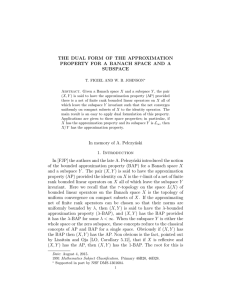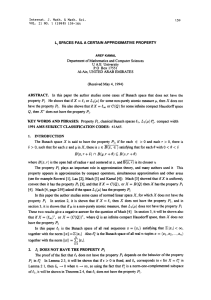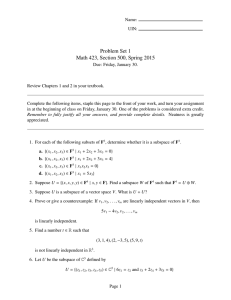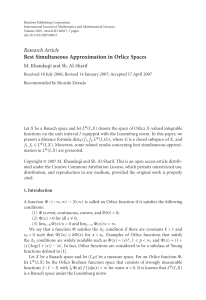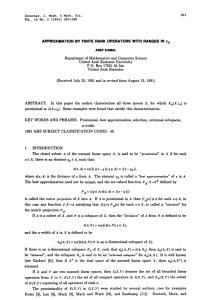Document 10439352
advertisement
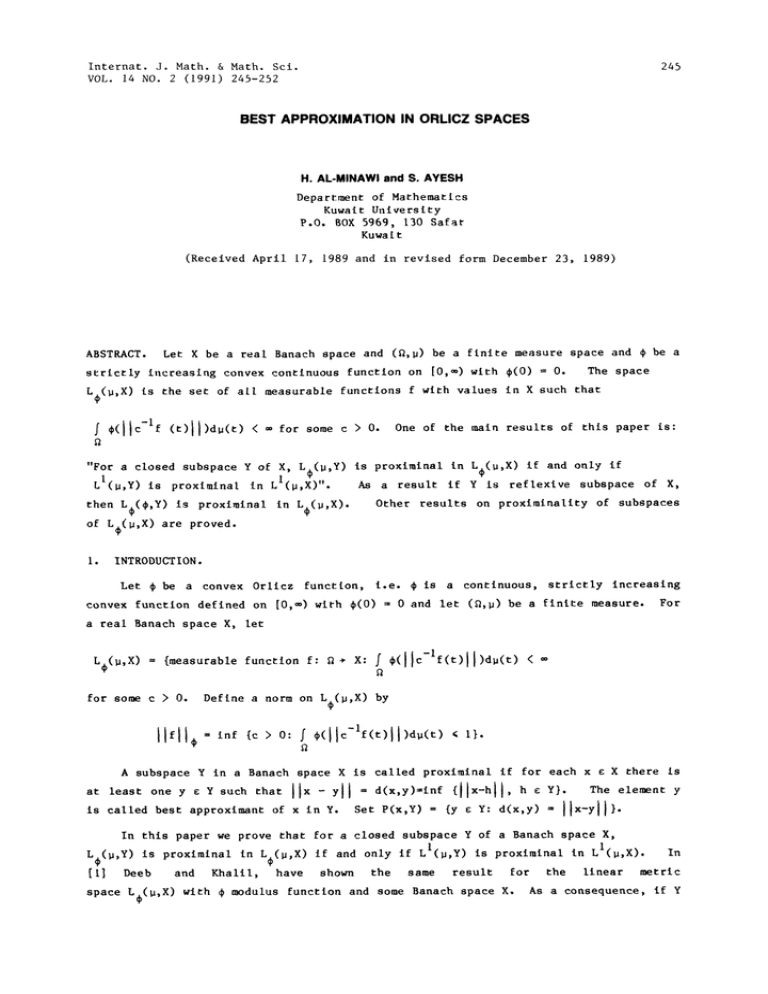
Internat. J. Math. & Math. Sci.
VOL. 14 NO. 2 (1991) 245-252
245
BEST APPROXIMATION IN ORLICZ SPACES
H. AL-MINAWI and S. AYESH
Department of Mathematics
Kuwait University
P.O. BOX 5969, I]0 Saf_t
Kuwa t
(Received April 17, 1989 and in revised form December 23, 1989)
ABSTRACT.
be a
Let X be a real Banach space and (,) be a finite measure space and
0.
The space
[0,) with (0)
strictly i1creasing convex continuous function on
L(,X)
is the set of all measurable functions f with values in X such that
is:
"For a closed subspace Y
of X,
L(,Y)
is proximinal in
LL(,Y) is proxlmina[ in LI(,X) ’’.
then
L(,Y)is proximinal in L(,X).
of
L(,X)
L(u,X)
if and only if
As a result if Y is reflexive subspace of X,
Other results on proximinality of subspaces
are proved.
INTRODUCTION
Let
i.e. $ is a continuous,
be a convex Orllcz function,
convex function defined on [0, =) with
strictly increasing
0 and let (,) be a [inlte measure.
(0)
For
a real Banach space X, let
L(,X)
for some c
X:
{measurable function f:
>
0.
llfll$
Define a norm on
inf {c
>
O:
L(v,X)
f (llc -I
by
(llc-lf(t)ll)d(t)
I}.
A subspace Y in a Banach space X is called proximlnal if for each x e X there is
In this paper we prove that for a closed subspace Y of a Banach space X,
is proximinal in
if and only if
is proximinal in
I]
space
Deeb
L(,X)
and
Khalil,
have
LI(,X).
LI(,Y)
L(,X)
L#(,Y)
shown
the
same
result
or
with # modulus function and some Banach space X.
the
linear
In
metric
As a consequence, if Y
246
H. AL-MINAWI AND S. AYESH
is a reflexive subspace of a Banach space X then
L$(u,Y)
is proximinal in
The prox|mina[Ity of so,e closed subspaces in X are discussed.
paper fl
wi[[
be the unit interval
O, (I)
$(0)
[0,I],
L(u,X).
Throughout this
convex, strictly increasing with
See Deeb and Khalil [1,2,3], Light and
and X is a Banach space.
Cheney [4], and Khal[l [5] for more details about proximinal[ty and related topics.
2.
PROXIMINAL[TY
LEMMA 2.1.
q Is convex,
If
Let f
PROOF.
L(,X).
IN
g
L(,X),
then
-
L(,X) LI(,X).
then
0
By Jansen’s Inequality, [6]
0
0
or
Hence
0
erefore
0
Hence f
LI(I,X).
LEMHA 2.2.
dist(f,
PROOF.
Let Y be a subspace of X, then for each f c
h0(,W)
inf{c
For any g
>
L(,Y)
O:
f0
L(p,X)
1 c-ldist(f(t)’Y)l d(t)
I}.
we have,
0
tnf {c
>
O:
f0 (]c-ldist(f(t),Y)l)d.(t)’"
By taking the infimum over g e
dist(f,L(v,Y))
)inf
{c
L(v,Y)
>
O:
1}.
we get
f0 (Ic-ldist(f(t),Y)i)dO(t)
I}.
247
BEST APPROXIMATION IN ORLICZ SPACES
>
Conversely, let
<
.
’
0 and let
be a simple funcrion in
L(p,X),such
tllat
n
Write f’
i=l
XlXi,
where x. e X and
functions on A i which are disjoint measurable sets in
Select h
Y such that
f’ e
Xi
are the characteristic
[0, I].
It is clear that
L(,X).
.
n
Let g
i=!
then
xh i
n
I ,<11
0
Hence g e
hl I>.<A>
i=l
L(g,Y),
<
=.
then
n
i=1
Since e is arbitrary, we have
dtst(f,L(p,Y))
REMARK 2.1.
For f e
(,
tnf{c
f
0
f (c-ldtst(f(t),Y))dp(t)
L@(u,X),
(---lf(t)-)dg(t)
C
o
O:
0
0
such that
>
c
o
I}.
248
H. AL-MINAWI AND So AYESH
COROLLARY 2.1.
of
L(,)
Is
a
Let Y be a closed subspace of X.
best
approxlmant
of
in
L(,Y)
To an elemen f of
and only if g(t)
if
L(B,X),
is
a
approxlmait of f(t) in Y.
Let g(t) be a best appoximant of f(t) in Y.
PROOF.
It follows that for any h e:
This means that
L(B,Y)
is increasing, we have
Since
-I
Then
0
0
Therefore
0
0
-h{t)
or
Conversely,
be a best approximant of
let,,,,g
dlst(f,L(,Y)) llf-gll. By Lemma 2.2 and
"’’....Ilf-gll
f
}(-
inf{c
>
Co
0
0:
f0 (c-ldlst(f(t),Y)}d(t)
dla(t)
f in
L(v,Y),
then
the previous remark, we have
I}
c
o
such that
f }((dtse(f(tI,YI)
Co
0
0
since
,
t, strictly
tnerea,tng and
g
best
-1
No e prove the tn theorem of ehts paper.
TEO 2.1. Let
be a elood ubepaeo o[ X, then the [ollotng are equivalent:
BEST APPROXIMATION IN ORLICZ SPACES
(1)
L(,Y)
is proxtm[na! in
L(U,X)
([i)
LI(,Y)
is proimina[ in
LI(,X).
PROOF
(1).
(it)
Let f
LO( p,X),
249
then by Lemma 2.I f e L (,X).
By the
assumption, there exists g e L (B,Y) such that
for every h :
LI(v,Y).
By lemma 2.10 [3], we have
Hence by Corollary 2.1 it follows that g is a best approxlmant of f in
Conversely: (i)
(il).
J:LI(p,X)
if f(t)
Lo(p,X by J(f)
O, and zero otherwise
L (,X).
for all f
if
g(t)
.
where
.(t)
f(t)
Then for c
Since
,X).
Hence J(f) e
To show that J is onto, let g
L#(
follows that J is (I-I).
L#(,Y).
Define a map
0 and zero otherwise.
Clearly f e
LI(u,X)
is
E
strictly increasing,
L#(B,X),
it
then take
and
(I (t)l l)
j(f)
II
)ll
g(t).
Thus
J^
is
exists g e
onto
L(,Y)
Now
such that
let f e L (v,X), then
L(B,X).
By
assumption
there
250
H. AL-MINAWI AND S. AYESH
for all
L+(B,Y),
then by Corollary 2.1 we have
LI(,Y)
Now take any h
then
for al
t.
Hence
As a corollary.
If Y is a reflexive subspace of X,
COROLLARY 2.2.
then
L(p,Y)is
prlxlmlnal
in
It follows from the main theorem and Theorem 1.2 in Kahalll [5].
THEOREM 2.2. Let Y be a proxlminal subspace of X. Then for every simple function
PROOF.
f e
L(,X),
PROOF.
P(f,
Let f
.
L(,Y))
XAiXi
is not empty.
be a simple function in
L(,X),
where A
I
are disjoint
n
measurable sets in [0,I].
Set g
2
i=l
XlYi,
where
Yi
P(Xl’
Y)"
Let h be any
BEST APPROXIMATION IN ORLICZ SPACES
L(p,Y),
element in
then
[nf{c
Hence g
E
P(f,
THEOREM
in
L(p,X),
251
>
O:
,
f0 <(llc (t<t)-h(t))l[)d(t)
I}
L(,Y)).
2.3.
Let
Y be
a
closed
of
subspace
X.
If
L0(p,Y)
Is
proxlminal
then Y is proxlmlnal in X.
L(,X)
LI(,Y)
From Theorem 2.1,
proximal In
is
implies that
X).
By Theorem I.I [2] this also Implies that L( ,y) is
proxlmlnal in L (,X).
For x
X by fx(t)
It
X, define
fl
x for all t
ft.
is clear that f
L ,X) for every x
X, so there exists h L (,Y) such that
x
PROOF.
proximinal
L(,Y)
LI(
in
fx:
p,Y).
w
In particular take w
f
Y
so
llfx hll llfx fyll
for every y s Y
for every y
Hence every t
E
[0,I]
Y.
gives a best approxlmant of x in Y.
inX.
The next theorem needs the following definitions:
Therefore Y is proximinal
252
H. AL-MINAWI AND S. AYESH
The subspace Y is called
DEFINITION 2.1.
x
projection Q:
there is a bounded
-summand of x
Y stJch rllat
on K.
DEFINITION 2.2.
Z
subspace
[n
X
The subspace Y is called 1-complemented in X if. there is a closed
that
projection.
THEOREM 2.4.
PROOF.
pof.
Let
Let X
.
X
Y
Z and
the
projection P: X
If Y is l-complemented in X, the
Y
: L(,,X)+
L(,Y)
Z [s
a
is proximinal in
contractive
L(,X).
Z be a contractive projection from X onto Z.
Z, P: X
Hence
L(,Z)an
p(f)
f2 for all fL(It, X)
pof
L(,Z) and L(u,X) L(,Y) L(,Z).
L(,X). By Lemma 1.6 [2] L(,Y) is proximlnal
Is a contractive projection onto
fheta
L,Y)
L(,X).
Hence
In
+
is
l-complemented In
REFERENCES
LP(,X),
0
<
p
<
I.
To appear
I.
DEEB, W. and KHALIL, R. Best Approximation in
in Journal of Approximation Theory.
2.
DEE8, W. and KAHLIL, R.
Camb. Phil. Soc.
Best Approximation In L(X,Y).
3.
KHALIL, R. and DEEB, W.
LP(,X)
4.
LIGHT, W.A. and CHENEY, E.W. Approximation Theory in Tensor Product Spaces.
Lecture Notes in Math. 1169, 1985.
5.
KHALIL, R. Best Approximation in
(1983), 277-279.
6.
ROYDEN, H.L.
7.
SINGER, I.
Best Approximation in
of Approximation Theory.
Real Analysls.
LP(I,X).
To appear in Math. Proc.
II.
To appear in Journal
Math. Proc. Camb. Phil. Soc.
49
Macmillan Publishing Co., Inc., New York, 1968.
Best Approximation in Normed Linear Spaces by
Subspaces, Sprlnger-Verlag, 1970.
Elements
of Linear




